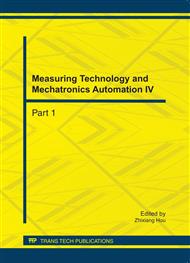[1]
Rauan Y H, Willett P, Marrs A, Palmieri F and Marano S, in: Practical fusion of quantized measurements via particle filtering[J]. IEEE Transactions on Aerospace and Electronic Systems, 2008, 44(1), 15-29.
DOI: 10.1109/taes.2008.4516986
Google Scholar
[2]
Gao xiang, Yang yintang and Zhou duan, in: Coverage of communication-based sensor nodes deployed location and energy efficient clustering algorithm in WSN[J]. Journal of Systems Engineering and Electronics, 2010, 21(4), 698-704.
DOI: 10.3969/j.issn.1004-4132.2010.04.025
Google Scholar
[3]
Information on http: /users. isr. ist. utl. pt/~mir/pub/kalman. pdf.
Google Scholar
[4]
Mihaylova L, Angelova D, Bull D R and Canagarajah C N, in: Localization of Mobile Nodes in Wireless Networks with Correlated in Time Measurement Noise[J]. IEEE Transactions on Mobile Computing, 2010, 10(1), 44-53.
DOI: 10.1109/tmc.2010.132
Google Scholar
[5]
Djuric P M , Vemula M and Bugallo M F, in: Target Tracking by Particle Filtering in Binary Sensor Networks[J]. IEEE Transactions on Signal Processing, 2008, 56(6), 2229-2238.
DOI: 10.1109/tsp.2007.916140
Google Scholar
[6]
Meesookho C, Narayanan, Raghavendra C S, in: Collaborative classification applications in sensor networks. In Proceedings of the Workshop on Sensor Array and Multichannel Signal Processing 2002, 370-374.
DOI: 10.1109/sam.2002.1191063
Google Scholar
[7]
Agarwal P and Sharir M, in: In Handbook of Computational Geometr[M]. Netherlands: J. -R. Sack and J. Urrutia Publications, (2000).
Google Scholar
[8]
Aslam J, Butler Z etc, in: Tracking a moving object with a binary sensor network. In Proceedings of ACM SenSys, 2003, 150-161.
Google Scholar
[9]
Yang yintang, Gao xiang, Chai changchun and Zhang jianxian, in: Novel Dynamic Routing Algorithm for Energy Optimization in WSN[J]. Journal of Xidian University, 2010, 37(5), 777-782.
Google Scholar
[10]
Krishnamachari B and Iyengar S, in: Distributed Bayesian algorithms for fault-tolerant event region detection in wireless sensor networks[J]. IEEE Transactions on Computers, 2004, 53(3), 241-250.
DOI: 10.1109/tc.2004.1261832
Google Scholar
[11]
Ristic B, Arulampalam S and Gordon N, in:Beyond the Kalman Filter: Particle Filters for Tracking Applications[M]. Artech House Publications, Boston : Artech House Publications, (2004).
Google Scholar
[12]
Agarwal P K, Har-Peled S, Mustafa N H and Wang Y S, in: Near-Linear Time Approximation Algorithms for Curve Simplification[J]. Algorithmica, 2005, 42(3-4), 203-219.
DOI: 10.1007/s00453-005-1165-y
Google Scholar
[13]
Shrivastava N, Mudumbai R, Madhow U and Suri S, in: Target tracking with binary proximity sensors[J]. ACM Transactions on Sensor Networks, 2009, 5(4), 30: 1-30: 33.
DOI: 10.1145/1614379.1614382
Google Scholar


